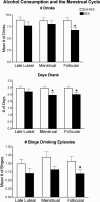Alcohol consumption as a function of dietary restraint and the menstrual cycle in moderate/heavy ("at-risk") female drinkers
- PMID: 22664414
- PMCID: PMC3368223
- DOI: 10.1016/j.eatbeh.2012.03.011
Alcohol consumption as a function of dietary restraint and the menstrual cycle in moderate/heavy ("at-risk") female drinkers
Abstract
Previous research suggests that women who report dietary restraint tend to consume alcohol in greater quantities, however most studies use retrospective data collection, which is often unreliable, and no studies have accounted for this relationship with respect to potential changes in alcohol consumption across the menstrual cycle. Therefore, the present study investigated the relationship between prospectively monitored drinking patterns and dietary restraint across the menstrual cycle among females from the general population whose drinking level (7-20 drinks/week) places them at-risk for developing alcohol use disorders. Restrained eaters (RES; N=51) and unrestrained eaters (UN-RES; N=55), per the cognitive restraint scale scores from the Three-Factor Eating Questionnaire, provided prospective ratings measuring mood, alcohol consumption, and consequences of alcohol use across one full menstrual cycle. Dysphoric mood increased during the late luteal and menstrual phases in both groups. Although overall the RES group did not drink more than the UN-RES group, the RES group drank less than the UN-RES group during the follicular phase, suggesting that among RES women alcohol consumption may be modulated by hormonal fluctuations across the menstrual cycle. The differences between the present findings and previous research may be due to the cohorts sampled; the majority of previous studies sampled college students, where binge drinking and dietary restraint are more common, whereas this study sampled the general population. Future research should replicate prior studies in a college-aged population using the current design of prospective data collection for greater accuracy of self-reported alcohol consumption.
Copyright © 2012 Elsevier Ltd. All rights reserved.
Figures
References
-
- Beck AT, Steer RA, Brown GK. BDI-II Beck Depression Inventory Manual. 2nd ed. The Psychological Corp Harcourt Brace and Company; San Antonio, TX: 1996.
-
- Bowen DJ, Grunberg NE. Variations in food preference and consumption across the menstrual cycle. Physiology and Behavior. 1990;47(2):287–291. - PubMed
-
- Bradstock K, Forman MR, Binkin NJ, Gentry EM, Hogelin GC, Williamson DF, Trowbridge FL. Alcohol use and health behavior lifestyles among U.S. women: The behavioral risk factor surveys. Addictive Behaviors. 1988;13(1):61–71. - PubMed
-
- Bryant EJ, Kiezebrink K, King NA, Blundell JE. Interaction between disinhibition and restraint: Implications for body weight and eating disturbance. Eating and Weight Disorders. 2010;15(1-2):e43–51. - PubMed
-
- Cahalan D, Cisin IH, Crossley HM. Quantity-frequency-variability index. In: Lettieri DJ, Nelson JE, Sayers MA, editors. NIAAA Treatment Handbook Series. Vol. 2. NIAAA; Rockville, MD: 1985. pp. 78–81.
Publication types
MeSH terms
Grants and funding
LinkOut - more resources
Full Text Sources
Medical


